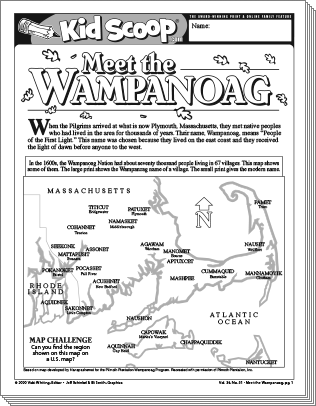 History tells us that the first Thanksgiving in America was held in Plymouth Colony and included both Pilgrims and members of the Wampanoag Nation. Without the help of this indigenous tribe of Native Americans, the Pilgrims likely would not have survived the first harsh winter in the new world. Sharing their seeds and farming techniques, the Wampanoag taught the Pilgrims how to plant, tend, harvest, and preserve corn and other food sources for the cold winter months. When it came time to give thanks for healthy and abundant crops, naturally the Wampanoag were included in the celebration and feast. But what about the Wampanoag point of view of these newcomers to their land? What did they think of the early settlers who were so unprepared for survival? This issue will introduce young historians to the Wampanoag Nation, their customs, beliefs, and knowledge of how to survive off the land.
History tells us that the first Thanksgiving in America was held in Plymouth Colony and included both Pilgrims and members of the Wampanoag Nation. Without the help of this indigenous tribe of Native Americans, the Pilgrims likely would not have survived the first harsh winter in the new world. Sharing their seeds and farming techniques, the Wampanoag taught the Pilgrims how to plant, tend, harvest, and preserve corn and other food sources for the cold winter months. When it came time to give thanks for healthy and abundant crops, naturally the Wampanoag were included in the celebration and feast. But what about the Wampanoag point of view of these newcomers to their land? What did they think of the early settlers who were so unprepared for survival? This issue will introduce young historians to the Wampanoag Nation, their customs, beliefs, and knowledge of how to survive off the land.
In this issue young historians will:
- read informational text about the Wampanoag Nation
- compare modern and ancient names of villages where Wampanoag lived
- read closely for context clues
- analyze a newspaper article from two different points of view
- compare two perspectives on a single incident
- use the newspaper to locate Thanksgiving items for a holiday game
- create a Thanksgiving poem using headline parts of speech
- write descriptively about why you are thankful
6 page PDF
